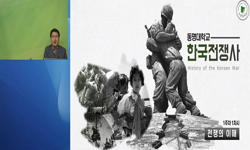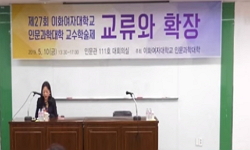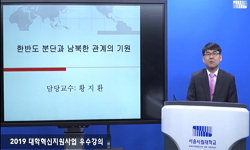한국전쟁 포로와 포로수용소에 관한 연구가 지속되어오고 있음에도 불구하고 ‘여성 포로’에 관한 연구는 전무하다고 해도 과언이 아니다. 비록 그 수가 남성 포로에 비해 현격히 적었지...
http://chineseinput.net/에서 pinyin(병음)방식으로 중국어를 변환할 수 있습니다.
변환된 중국어를 복사하여 사용하시면 됩니다.
- 中文 을 입력하시려면 zhongwen을 입력하시고 space를누르시면됩니다.
- 北京 을 입력하시려면 beijing을 입력하시고 space를 누르시면 됩니다.

한국전쟁과 여성 포로 표상의 젠더 정치 = The Korean War and the Gender Politics of Representation of Female Prisoners of War
한글로보기부가정보
국문 초록 (Abstract)
한국전쟁 포로와 포로수용소에 관한 연구가 지속되어오고 있음에도 불구하고 ‘여성 포로’에 관한 연구는 전무하다고 해도 과언이 아니다. 비록 그 수가 남성 포로에 비해 현격히 적었지만 여성 포로는 엄연히 존재했다. 한국전쟁은 포로 전쟁이라고 할 만큼 개전 초기부터 포로 처리를 둘러싸고 남/북한과 미국 사이에 이견과 갈등이 존재했고, 그런 만큼 당시 신문지상을 통해 포로수용소 및 포로에 관해 확인하는 것은 어려운 일이 아니다. 하지만 그러한 기사의 대부분은 이념의 경계 구획 속에서 포로를 위치시키고 규정하며 낙인찍는 과정을 보여준다. 여성 포로의 경우에도 기본적으로 친공/반공이라는 이분법적 도식 속에서 여성 포로를 위치시키고, 그녀들을 관찰하거나 그녀들의 목소리를 전하고 있다. 또한, 남성 군인을 잣대로 하여 그녀들이 군대식 규율 권력을 훼손하는 존재라는 점을 부각시키면서 반공 여성 포로의 표상을 스테레오 타입화하고 있었다. 1990년대 이후 남성 포로의 체험과 기억을 담고 있는 기록과 증언에서 여전히 좌우 이념의 경계 속에서 남성 시각 주체에 포착된 대상으로서 여성 포로를 재현하여 인식하게 만들고 있다. 이는 냉전-분단 체제기를 거쳐 탈냉전-신자유주의 체제기에 접어든 1990년대 이후에도 여전히 한국전쟁에 관한 남성 젠더의 체험과 기억, 증언과 글쓰기가 여성을 타자화하여 성적으로 대상화하고 있을 뿐만 아니라 이념의 경계선을 작동하고 있음을 드러낸다. 한편, 여성 포로의 문학적 표상은 공산주의 이념에 물든 ‘빨갱이’나 지성과 미모를 갖춘 ‘팜므 파탈’의 이미지로만 재현되지 않는다. 여성 포로가 스스로 자신의 신념을 말하는 주체로서, 포로 이후의 트라우마적 기억을 극복하는 주체로서 움직이고 있다는 점에서 여성 포로의 문학적 표상은 전후 냉전-분단 체제기 남한사회의 젠더 정치의 이분법적 위계 구도에 균열을 발생시킬 수 있는 가능성을 보여준다.
다국어 초록 (Multilingual Abstract)
Although research on Korean War POWs and POW camps continues, it is no exaggeration to say that there is no research on ‘female POWs’. Although their number was significantly smaller than that of male prisoner’s, there were definitely female pri...
Although research on Korean War POWs and POW camps continues, it is no exaggeration to say that there is no research on ‘female POWs’. Although their number was significantly smaller than that of male prisoner’s, there were definitely female prisoners. The Korean War can be called a prisoner’s war, so there were differences of opinion and conflict between South and North Korea and the United States over the treatment of prisoners from the beginning of the war. As such, it is not difficult to find out about POWs and POW camp through newspapers at the time. However, most of such articles show the process of positioning, defining, and stigmatizing prisoners within ideological boundaries. In the case of female POWs, they are basically placed in a dichotomous scheme of pro-communism/anti-communism, and they are observed or their voices are conveyed. In addition, by using male soldiers as the standard, they were stereotyping the representation of anti-communist female prisoners by emphasizing that they were beings that undermined military disciplinary power. Since the 1990s, records and testimonies containing the experiences and memories of male prisoners still represent and recognize female prisoners as objects captured by male visual subjects within the boundaries of left and right ideologies. This means that even after the 1990s, which went through the Cold War-division regime and entered the post-Cold War-neoliberal regime, the male gender’s experiences, memories, testimonies, and writings about the Korean War not only otherize women and sexually objectify them, but also operate the borderline of ideology. Meanwhile, the literary representation of female POWs is not only represented by the image of a ‘communist’ steeped in communist ideology or a ‘femme fatale’ with intelligence and beauty. In that female POWs act as subjects who speak out their own beliefs and overcome traumatic memories after captivity, the literary representation of female POWs is shows the possibility of causing cracks the dichotomous hierarchical structure of gender politics in South Korean society during the Cold War-division regime.
동일학술지(권/호) 다른 논문
-
- 한국문학연구학회
- 류상범
- 2023
- KCI등재
-
『제국신문』의 국문 인식과 한글 독자(2) - 독자 편지를 중심으로
- 한국문학연구학회
- 권두연
- 2023
- KCI등재
-
1980년대 무크 문학의 편집 내용과 전략 - ‘확산적 방향의 종합’과 ‘포괄적 방향의 종합’
- 한국문학연구학회
- 김보경
- 2023
- KCI등재
-
잔류, 낙인 그리고 환대를 위하여 - 전후 재한 일본인 처의 삶과 재현을 중심으로
- 한국문학연구학회
- 장세진
- 2023
- KCI등재





 KCI
KCI KISS
KISS






